We LOVE Science!!
What is Permafrost?
Can you believe that in some places on Earth the ground stays perpetually frozen? If soil and sediment remain frozen for two or more years in a row it is considered permafrost. Permafrost makes up 24% of the land in the northern hemisphere, mostly near the north pole. Ground containing permafrost is layered with a seasonally frozen "active layer" above the permanently frozen layer. Under this is an unfrozen layer called talik.
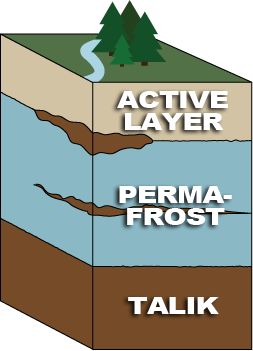 Idealized permafrost cross section. Image credit wunderground.com
Idealized permafrost cross section. Image credit wunderground.com
A moose! Two moose/mooses/meese? No it's two moose.
Our group bundled up and headed out to the CRREL Permafrost Tunnel near Fox, Alaska. The tunnel was excavated in 1963-1969 and is owned by the U.S. Army Cold Regions Research and Engineering Laboratory partnered with the University of Alaska, Fairbanks Institute of Northern Engineering. The tunnel is not open for public tours, so it was a special treat to get to go inside. Traveling out of town we saw a moose! She was just hanging out. She had a calf with her that was a short distance away.
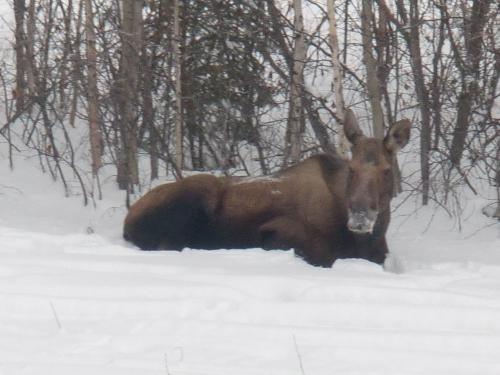 As we drove to the Permafrost Tunnel we saw this moose with her calf.
As we drove to the Permafrost Tunnel we saw this moose with her calf.
The Trans-Alaska Pipeline
We also stopped to take a look at the Trans-Alaska Pipeline. The Trans-Alaska Pipeline was built between 1974 and 1977 after the oil crisis in 1973. This happened because oil producing countries in the Middle East proclaimed that they weren't going to trade with the United States. So the U.S. got busy exploring the north coast of Alaska, specifically the Prudhoe Bay Oil Field. There was plenty of oil there, but no way to ship it out as Prudhoe Bay is iced in much of the year. Trucking it through the interior of Alaska would be expensive and time consuming considering the quantity of oil. So the Trans-Alaskan Pipeline was built to bring the oil from Prudhoe Bay to Valdez, Alaska on the southern coast where it is shipped out. The pipeline transverses 800 miles cutting right through the heart of Alaska.
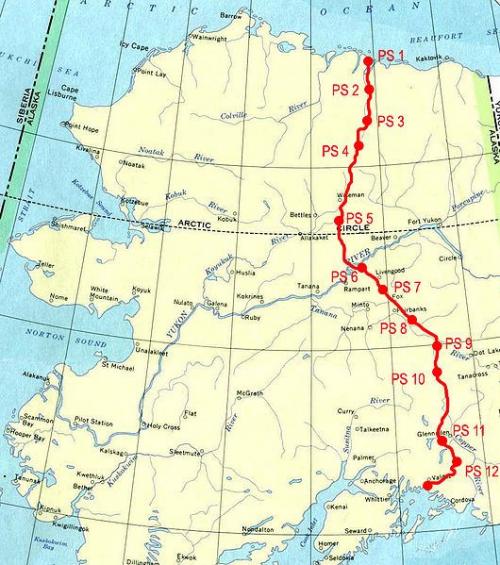 Location of Trans-Alaska pipeline
Location of Trans-Alaska pipeline
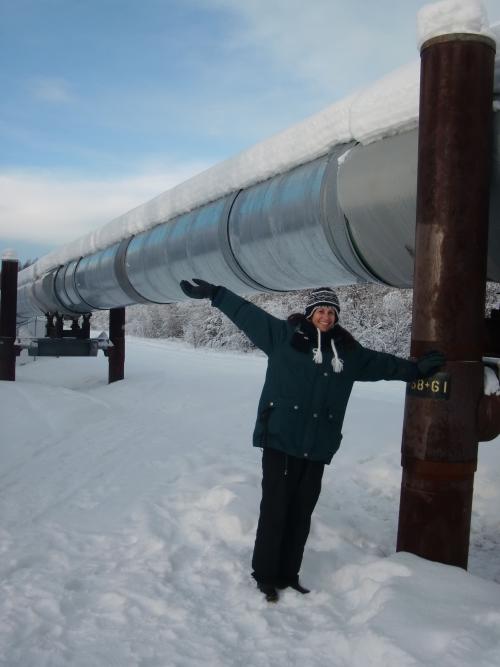 The Trans-Alaskan Pipeline transports oil through the heart of Alaska to supply gasoline to people like you and me.
The Trans-Alaskan Pipeline transports oil through the heart of Alaska to supply gasoline to people like you and me.
The Permafrost Tunnel
The Permafrost Tunnel is a way to experience and research permafrost from the inside. The first thing I noticed was the smell, which I would describe kind of like a rotten, sour, barn odor. Not good. I still have that smell in my scarf I noticed last night when I put it on..... Next, it is very dusty in there. As we tromped through the dust our boots and pants were quickly covered in a fine layer of brown. In fact if you scrape a bit at the wall with your fingers it just falls off as a fine powder to a few millimeters deep. Under that, it is rock hard and frozen solid. But as our eyes adjusted we began noticing what looked like dead vegetation hanging from the ceiling and strange shapes protruding from the walls that looked like weird bones and horns. Could it be? Yes, these were the remains of ancient, extinct plants and animals.
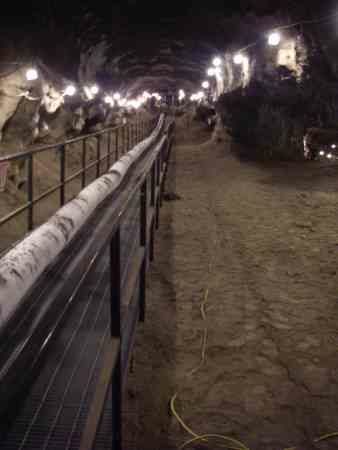 The Permafrost Tunnel is composed of fine-grained silt, ice, and soil mixed with organic material dating back 40,000 years. Inside the Permafrost Research Tunnel in Fox, Alaska. Photo by Jacquelyn Hams (PolarTREC 2008), Courtesy of ARCUS
The Permafrost Tunnel is composed of fine-grained silt, ice, and soil mixed with organic material dating back 40,000 years. Inside the Permafrost Research Tunnel in Fox, Alaska. Photo by Jacquelyn Hams (PolarTREC 2008), Courtesy of ARCUS
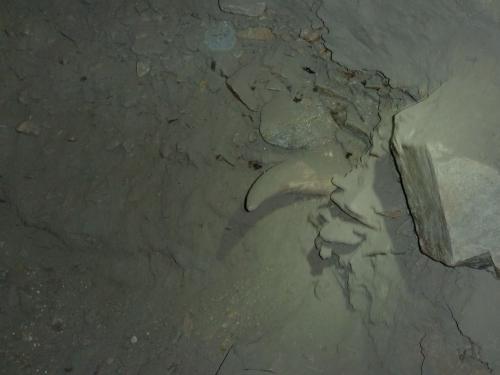 This horn from an extinct large-horned bison is around 14,000 years old.
This horn from an extinct large-horned bison is around 14,000 years old.
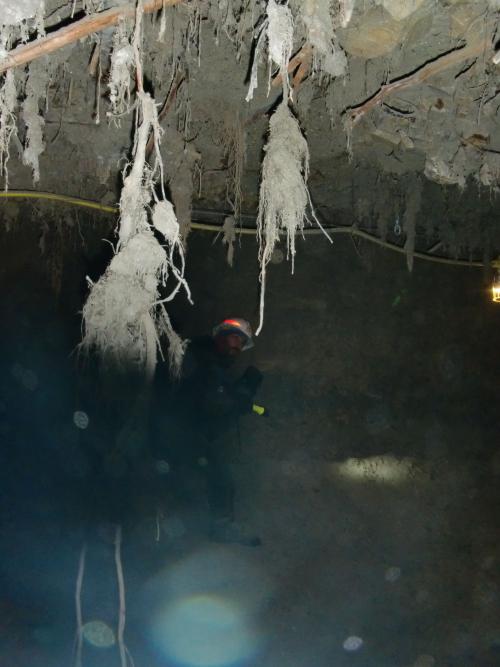 The vegetation that hangs from the ceiling has been frozen for thousands of years.
The vegetation that hangs from the ceiling has been frozen for thousands of years.
Pleistocene Epoch Life
The Permafrost Tunnel preserves animal and plant remains from the Pleistocene Epoch, 2,588,00 to 11,700 years ago. This time spans the world's recent period of repeated glaciation. The interior of Alaska was not glaciated, however mountain ranges to the north and south were. As these glaciers pushed debris ahead of them, strong winds blew the debris into the interior of Alaska where it accumulated as a fine till called loess. It was so cold that it froze during accumulation and exists as the permafrost layer that we see today. The plant and animal remains represent a very different era when the interior of Alaska was a tundra with grasses. (Today it supports a boreal forest.) Animals that have since become extinct populated the tundra such as large-horned bison and saber-toothed cats.
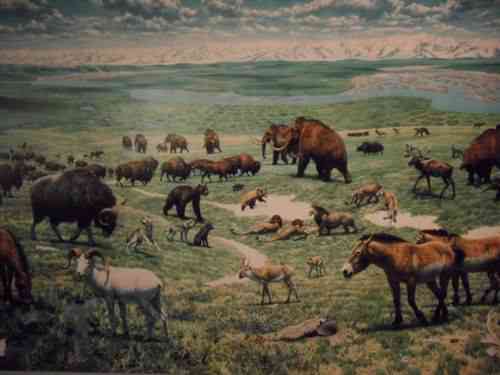 This is an artist's idea of what the area around the Bering land bridge may have looked like at the closing of the last ice age about 12,000 years ago. The artist, Jay Matternes, included many animals which are now extinct, including ground sloth, northern horse, saber-toothed cats, large-horned bison and even a lion-like cat. Image credit Karl Horeis
This is an artist's idea of what the area around the Bering land bridge may have looked like at the closing of the last ice age about 12,000 years ago. The artist, Jay Matternes, included many animals which are now extinct, including ground sloth, northern horse, saber-toothed cats, large-horned bison and even a lion-like cat. Image credit Karl Horeis
Ice Wedges
As we proceeded deeper into the tunnel we noticed that glints of light began reflecting off the surfaces. These are ice wedges that penetrate deep into the permafrost.
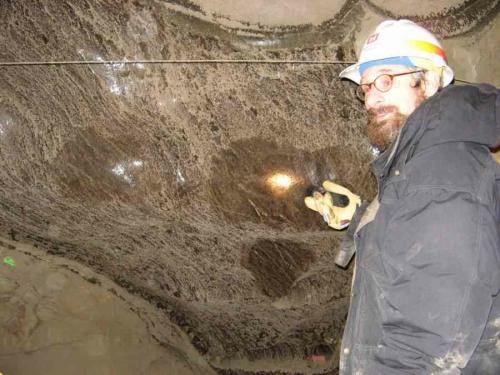 Matthew Sturm shows an ice wedge inside the CRREL Permafrost Tunnel in Fox, Alaska. Photo by Betsy Wilkening (PolarTREC 2009), Courtesy of ARCUS
Matthew Sturm shows an ice wedge inside the CRREL Permafrost Tunnel in Fox, Alaska. Photo by Betsy Wilkening (PolarTREC 2009), Courtesy of ARCUS
Ice wedges form because during the winter months the ground actually cracks (a few centimeters wide) due to thermal contraction (because the ground gets really cold). During the summer, the snow melts and flows into these tiny cracks where it freezes into ice due to the permafrost. When the water freezes it expands, creating more cracks for melted snow to fall into the next year. This process of cracking and freezing causes the ice wedge to grow. Ice wedges can grow to 3-4 meters in length and extend down into the ground for several meters.
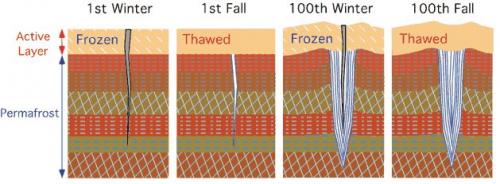 The following series of graphics showing the evolution of ice wedges. Image Credit PhysicalGeography.net
The following series of graphics showing the evolution of ice wedges. Image Credit PhysicalGeography.net
Polygons
One thing that I think is really cool is that on the surface interconnected ice wedges form large polygonal structures. Check out the polygonal pattern in the picture below.
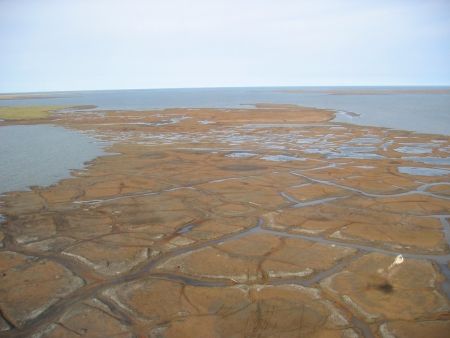 Flying over the tundra near Barrow, AK. Notice the tundra polygons formed because of the freeze-thaw cycle that occurs in permafrost areas. You can see the patterns of polygons and ponds. Photo by Leslie Pierce (TREC 2005), Courtesy of ARCUS
Flying over the tundra near Barrow, AK. Notice the tundra polygons formed because of the freeze-thaw cycle that occurs in permafrost areas. You can see the patterns of polygons and ponds. Photo by Leslie Pierce (TREC 2005), Courtesy of ARCUS
Mars
Now check out this picture! This picture was taken by the Opportunity Rover on the Meridiani Plain on Mars! Do you notice the similarity? Scientists are unsure exactly how these formed but are confident they formed in a water environment. However they formed, it reminds us that, as alien as Mars may seem, it is in many ways remarkably similar to Earth.
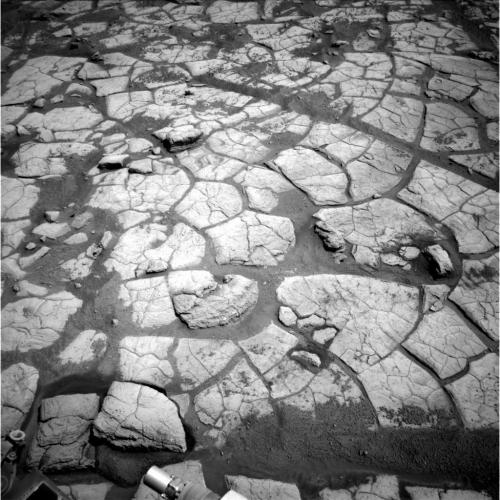 This picture taken by Mar's Rover, Opportunity shows polygonal patterns on the surface of Mars that are very similar to ice wedging polygons on Earth. How could they have formed? Credit: NASA/JPL
This picture taken by Mar's Rover, Opportunity shows polygonal patterns on the surface of Mars that are very similar to ice wedging polygons on Earth. How could they have formed? Credit: NASA/JPL
What does this mean for the future?
Worldwide permafrost is a significant carbon reservoir storing 25-50% of the Earth's soils' organic carbon. As permafrost thaws, the organic material decomposes and releases carbon in the form of methane. Under "normal" conditions, seasonal thawing and decomposition is very slow. However, with a warming climate the potential for accelerated methane release is great. Methane is a powerful greenhouse gas and putting more of it into atmosphere would be a bad, bad thing.
Now for some questions
Wow, that was a lot of information! Here are some things to think about. Put your responses in the comments section and don't forget to put your first name (if you want) in the body of the comment so I know who you are. Ask me some questions too! Anyone can respond.
Why do you think they built the Trans-Alaskan Pipeline above the ground instead of making it an underground pipeline?
Why do you think it is smelly inside the Permafrost Tunnel?
Why are the surfaces of the Permafrost Tunnel dusty instead of frozen solid? (Hint- it isn't because the frost melted, it isn't wet inside at all. Note to my students- think of another change of state.)
Most substances contract when they freeze, yet water expands. Why? (Hint to my students- we have talked about the structure of a water molecule and what it does when it freezes.)
On Titan, a moon of Saturn, it is so cold that water ice is as hard as steel and methane (a gas at normal temperatures and pressures on Earth) exists in liquid lakes and falls as liquid rain. Titan has a thick methane atmosphere and a methane cycle perhaps similar to our water cycle. If methane is such a potent greenhouse gas, why isn't it warming up Titan?


Comments
Pagination